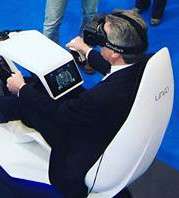Drive by wire
Drive by wire, DbW, by-wire, Steer-by-wire, or x-by-wire technology in the automotive industry is the use of electrical or electro-mechanical systems for performing vehicle functions traditionally achieved by mechanical linkages. This technology replaces the traditional mechanical control systems with electronic control systems using electromechanical actuators and human-machine interfaces such as pedal and steering feel emulators. Components such as the steering column, intermediate shafts, pumps, hoses, belts, coolers and vacuum servos and master cylinders are eliminated from the vehicle. This is similar to the fly-by-wire systems used widely in the aviation industry.
Examples include electronic throttle control and brake-by-wire.
Advantages
Because the steering wheel can be bypassed as an input device, safety can be improved by providing computer controlled intervention of vehicle controls with systems such as electronic stability control (ESC), adaptive cruise control and Lane Assist Systems. Some systems, with appropriate modification, allow for control by laptops or even game controllers.[1]
Ergonomics can be improved by the amount of force and range of movement required by the driver and by greater flexibility in the location of controls. This flexibility also significantly expands the number of options for the vehicle's design.
Eliminating mechanical linkages can provide savings in weight.[2]
Drive-by-wire is a key enabling technology for autonomous vehicle development.[3]
Disadvantages
Drive by wire systems can be "hacked", and their control faulted or shut off, by either wired[4] or wireless[5] connections.
Uses in passenger cars
Throttle by wire
This system helps accomplish vehicle propulsion by means of an electronic throttle without any cables from the accelerator pedal to the throttle valve of the engine. In electric vehicles, this system controls the electric motors by sensing the accelerator pedal input and sending commands to the power inverter modules.
Brake by wire
A pure brake by wire system would eliminate the need for hydraulics completely by using motors to actuate calipers, in comparison to the currently existing technology where the system is designed to provide braking effort by building hydraulic pressure in the brake lines.
Shift by wire
The direction of motion of the vehicle (Forward, Reverse) is set by commanding the actuators inside the transmission through electronic commands based on the current input from the driver (Park, Reverse, Neutral or Drive).
Steer by wire

This kind of system will provide steering control to a car with fewer mechanical components/linkages between the steering wheel and the wheels.[6] The control of the wheels' direction will be established through electric motor(s) which are actuated by electronic control units monitoring the steering wheel inputs from the driver. Such a system is illegal in most jurisdictions for passenger or commercial vehicles.
The first production vehicle to implement this was the Infiniti Q50.,[7] but after negative comments they retrofitted the traditional hydraulic steering.[8] Its implementation in road vehicles is limited by concerns over reliability although it has been demonstrated in several concept vehicles such as ThyssenKrupp Presta Steering's Mercedes-Benz Unimog, General Motors' Hy-wire and Sequel, Saabs Prometheus and the Mazda Ryuga. A rear wheel SbW system by Delphi called Quadrasteer is used on some pickup trucks but has had limited commercial success.
The Swedish startup Uniti will release the Uniti all electric car in 2019 with an in-house designed steer-by-wire system and will entirely replace the steering wheel.[9] The concept was showcased in VR at the 2016 CeBit edition.[10]
This is not to be confused with Electric Power Steering. Electric Power Steering can be considered as a stage of evolution from mechanical steering to steer by wire systems.
Park by wire
The parking pawl in a traditional automatic transmission has a mechanical link to the gear lever and locks the transmission in the park position when the vehicle is set in Park. Not to be confused with the parking brake. A park by wire system uses electronic commands to actuate the parking pawl by a motor when the driver puts the vehicle in park.
Safety critical systems
Failures in electronic control units used to implement these drive by wire functionalists can lead to potential hazardous situations where the driver's ability to control the vehicle will depend on the vehicle operating scenario. For example, unintended acceleration, loss of braking, unintended steering, shift in the wrong direction and unintended roll away are some of the known hazards. Implementing drive by wire systems requires extensive testing and validation as is the case when any new technology is introduced.
Recently it has been demonstrated that some of these systems are susceptible to hacking, allowing for external control of the vehicle. While generally such hack demonstrations like remote activation of the horn or windshield wipers/washers fall into the "annoying or amusing" category, other hacks involving the accelerator, brakes, and transmission have much more serious security and safety implications.[11]
References
- ↑ "I used a PS4 controller to drive a car". TechRadar.
- ↑ "Are You Ready for Drive-by-Wire?".
- ↑ "Drive by Wire definition". Level Five Jobs.
- ↑ Greenberg, Andy. "Hackers Reveal Nasty New Car Attacks--With Me Behind The Wheel (Video)".
- ↑ Greenberg, Andy. "Hackers Remotely Kill a Jeep on the Highway—With Me in It".
- ↑ "Steer By Wire".
- ↑ Jancer, Matt. "Take a Look Inside the First Steer-by-Wire Car".
- ↑ O'Kane, Tony (2 September 2014). "2016 Infiniti Q50 To Get 'Old Fashioned' Hydraulic Power Steering: Report". themotorreport.com.au. Retrieved 13 April 2018.
- ↑ "Uniti Sweden website". Uniti. Retrieved 2017-06-07.
- ↑ "Uniti: Winziges umweltfreundliches Elektroauto auf der CeBIT". computerbild.de (in German). Retrieved 2017-06-07.
- ↑ Checkoway, Stephen. "Comprehensive Experimental Analyses of Automotive Attack Surfaces". YouTube. Retrieved 23 August 2018.